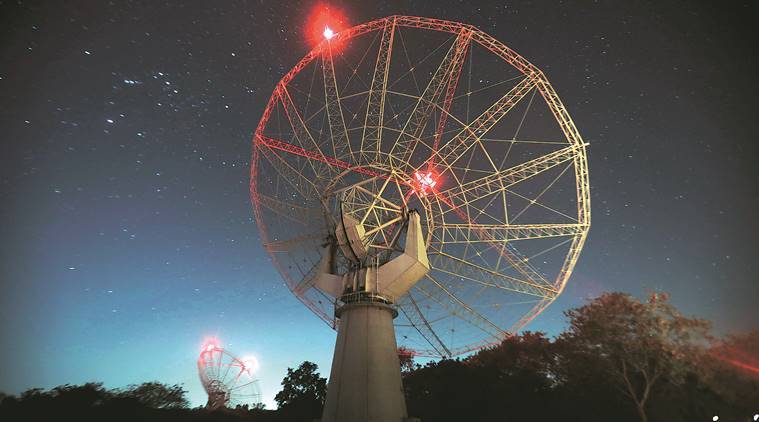 This signal was then combined with the four European VLBI Network (ENVI) telescopes to give fringes on these baselines with the uGMRT. An interferometric array of radio telescopes spread throughout Europe, Asia, South Africa and the Americas, the EVN has, since 1980s, been conducting radio astronomical observations of cosmic radio sources.
This signal was then combined with the four European VLBI Network (ENVI) telescopes to give fringes on these baselines with the uGMRT. An interferometric array of radio telescopes spread throughout Europe, Asia, South Africa and the Americas, the EVN has, since 1980s, been conducting radio astronomical observations of cosmic radio sources. India’s Giant Metrewave Radio Telescope (GMRT), along with four other international radio telescopes, has succeeded in detecting fringes from an extremely bright quasar located 12.3 billion light years away.
Quasars are galaxies that release enormous amounts of energy. They are of great interest among astronomers worldwide as they launch powerful radio jets when matter falls into super-massive black holes.
It was during the two experiments conducted in February this year that astronomers detected Very Long Baseline Interferometry (VLBI) fringes from this distant quasar, identified as 3C 454.3.
Scientists obtain a fringe when data from a pair of antennas from one telescope are combined to successfully obtain a correlated signal, all while observing the same source. A pair of antennas is called a baseline. The longer it gets, the improved angular detail or simply resolution it offers.
Subscriber Only Stories
Simply put, longer baselines permit astronomers to get finer and far more detailed structure of the galactic source under study, due to the larger distance separation obtained between the pair of antennas.
GMRT joined hands with the Medicina and Noto Radio Observatories in Italy, the Westerbork Synthesis Radio Telescope located in the Netherlands and the Zelenchukskaya Radio Astronomical Observatory from Russia for these experiments.
The longest separation between a pair of GMRT antennas — 30 in total — is 25 km. But these two multinational experiments, done in the 1000-1450 Mega Hertz (MHz) band, saw the data synthesis of a large telescope offering a baselines of about 6,000-km length across Europe and Asia. Such a technique is called Very Long Baseline Interferometry (VLBI). This improved the baseline measurements by 3 to 10 milliarcseconds. Signals picked up by 10 of the uGMRT antennas were added into the phased array of the remaining four telescopes. This produced an output as high as what it would generate when all were fused into a single antenna, with 10 times larger collecting area of the sky.
This signal was then combined with the four European VLBI Network (ENVI) telescopes to give fringes on these baselines with the uGMRT. An interferometric array of radio telescopes spread throughout Europe, Asia, South Africa and the Americas, the EVN has, since 1980s, been conducting radio astronomical observations of cosmic radio sources.
Prof Yashwant Gupta, director of NCRA, noted the GMRT’s participation as a leap in paving the way for similar global VLBI networks from Japan, Australia, Europe and other countries in the future.
Another scientist from NCRA, Professor Preeti Kharb, said the EVN-only image of the quasar showed an unresolved and single source of radio emission. “The combined EVN – GMRT image distinguished this compact radio source into as a core-jet structure, with the radio jet pointing towards the west in the sky. This was seen as the faint extension of the contours towards the top-right side in the image with GMRT data included. This brings out the importance of the VLBI,” said Kharb.
- The Indian Express website has been rated GREEN for its credibility and trustworthiness by Newsguard, a global service that rates news sources for their journalistic standards.

